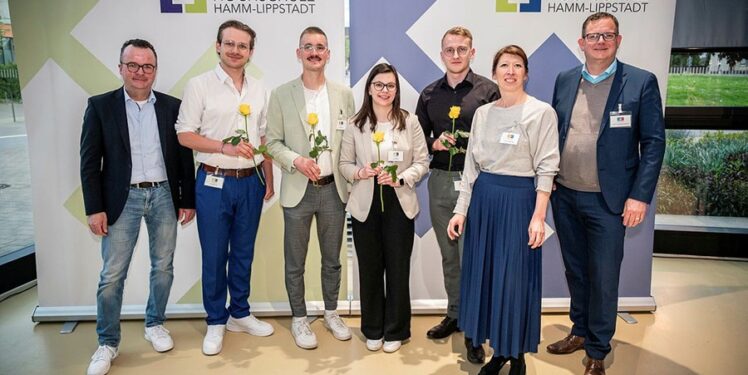Every year, regional companies and institutions award numerous scholarships to students at Hamm-Lippstadt University of Applied Sciences (HSHL). At this year’s scholarship ceremony, particularly successful and committed scholarship holders were honored. This time, first place in the sustainability category went to Niklas Hug from the “Material Design Bionics and Photonics” study program. For his bachelor’s thesis, he researched the biointelligent optimization of 3D bioprinting processes for fungal mycelium composite materials. He carried out the practical research at the Fraunhofer Institute for Interfacial Engineering and Biotechnology IGB in Stuttgart.
As part of his bachelor’s thesis, Niklas Martin Hug developed a method for evaluating fungal mycelium composite materials for 3D bioprinting applications. These so-called “engineered living materials” (ELMs) consist of living cells – in this case fungal mycelium – which are embedded in a bio-based matrix and can take on specific desired properties, such as strength or self-healing. The aim is to create new biointelligent materials from renewable raw materials such as hemp, sawmill residues, fungal mycelium and plant-based binders, which could replace plastic, wood, polystyrene or even concrete in certain applications – for example in packaging, as insulating material or for biodegradable components.
Fraunhofer IGB provides expertise and infrastructure
Hug contacted the Fraunhofer IGB for the necessary research work, as the Fraunhofer IGB has been developing inks and materials for 2D and 3D printing in the Functional Surfaces and Materials innovation field for many years. IGB’s work focuses on researching and producing suitable ink formulations that can be further processed into a wide range of functional components such as hydrogels, nano- and microparticles, proteins and cells. With this expertise and experience, the institute was exactly the right partner for Hug’s project. The young scientist joined the institute as a student assistant. During his time at the IGB in Stuttgart, bioprinting expert Dr. Achim Weber supported him as a supervisor and reviewer for his bachelor’s thesis.
Development to application readiness: material tests and formulation design
The expertise and infrastructure of the institute enabled Hug to reliably test the mechanical properties of the ELMs he developed. This allowed Hug to produce standardized test specimens and test them for their tensile and compressive strength. Of particular note is the development of a reproducible ink formulation for 3D printing – a key to consistent results and subsequent industrial applications. The samples achieved moduli of elasticity of up to 77.5 MPa in the tensile test and up to 3.97 MPa in the compression test. The work thus creates an important basis for the EU-funded IGB research project “LoopOfFun”, in which ELMs are being further developed as future-proof, sustainable materials.
“Loop of fun” – New approach to sustainable waste recycling in 3D printing
In this EU-funded project, the astonishing diversity of fungal species and their ability to synthesize bioactive metabolites are being used to produce new technical materials. Specifically, fungal mycelia are to be used as structural materials and for environmental technology. To this end, the fungi are optimized for specific material properties using an automated robot platform in so-called design-build-test-learn cycles. With this systematic approach, the IGB researchers can then develop materials that are robust against environmental influences and at the same time have tailored mechanical and structural properties. This results in future-proof materials for additive manufacturing that can be flexibly adapted to different requirements. Hug was able to seamlessly pick up on this with his research interest.
Hamm-Lippstadt University of Applied Sciences honors successful development with sustainability prize
The HSHL sustainability prize is awarded by the Volksbank Beckum-Lippstadt and is endowed with a total of 4,000 euros. Prize winner Hug received the sum of 1,500 euros for first place.
His scientific supervisor at IGB, Dr. Achim Weber, is also celebrating with the award winner: “We would like to congratulate Niklas Hug on this award and would like to take this opportunity to thank him once again for his outstanding work at our institute.” For the PhD chemist, scientific collaborations such as Niklas Hug’s project are a highly welcomed addition to his own routine research. That is why he is also happy to carry out further projects with young scientific talents, who often provide valuable new inspiration with fresh ideas and an open mindset. Students are welcome to apply at any time – with their own projects or in response to current IGB calls for proposals.
Photos: HSHL/Oliver Felchner

